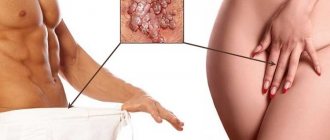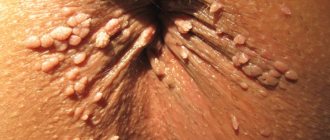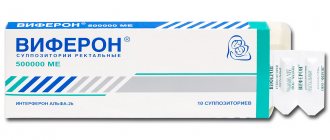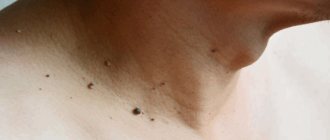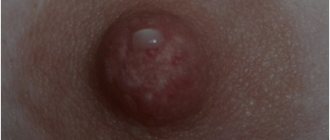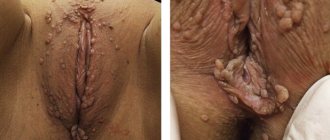Genital warts in men appear on the mucous membranes of the genital organs when infected with human papillomavirus types 6 and 11. These seemingly harmless tumors can lead to serious complications. To prevent this, you should contact a specialist as soon as possible and remove the condylomas.
Genital warts in a man
At the Diana Clinic, patients can receive comprehensive medical care for diagnosing the HPV virus and removing genital warts in men.
Clinical picture of condyloma
Condyloma is a benign change caused by more than 30 low-risk HPV types (most commonly 6 and 11). In men, they are most often found in the external genitalia (penis, foreskin) or in the anal area.
There are several forms, the most common of which are:
- genital warts (condyloma accuminata);
- flat warts (condyloma plan);
- giant Buschke-Levenshtein condyloma;
- bowenoid papulosis;
- genital wart (Condyloma accuminata).
The neoplasm appears soft, pink, with a rough surface and outwardly similar in shape to cauliflower. Less commonly, they can fuse together and form clusters larger than 6 cm. They can appear at any age, but usually occur in young, sexually active people aged 20 to 40 years.
In men, they are mainly located at the tip of the penis or in the anal area, but they can also be found inside the urethra or in the groin area.
Particular attention should be paid to condylomas in children, as they can develop as a consequence of sexual abuse.
Why do genital warts in men need to be removed?
Single small condylomas do not need to be removed if they do not bother the patient and do not cause concern to the doctor. In this case, constant monitoring is indicated. However, in most cases, doctors recommend getting rid of skin growths. This is necessary to prevent the development of complications.
In men, genital warts can cause the following complications:
- injury to tumors when wearing tight clothes, physical activity, during sex;
- infection of the wound surface;
- development of balanoposthitis as a result of suppuration;
- secondary urethritis (inflammation of the urethra);
- progression of infection with transition to prostatitis;
- further tissue growth with transition to healthy areas;
- genital cancer (exact mechanism unknown).
Treatment of condyloma
Electrocoagulation
Electrocoagulation is the cauterization of condyloma with high frequency current. Most often it is used if the area covered by condyloma is small. Blood loss is minimal, the procedure is performed under local anesthesia and is absolutely painless.
Surgical laser
Surgical removal of condyloma with a laser is one of the most effective treatment methods. The advantage of laser technology is high precision without blood loss, since only changed tissue is removed. At the same time, the laser beam destroys all viruses, bacteria and fungi. The surgical field remains completely sterilized, which accelerates wound healing without postoperative scars and deformities.
Cryotherapy
Cryotherapy is a method of freezing tissue for destruction. Liquid nitrogen is usually used, the temperature of which is -195.8 ° C.
The mechanism of action involves the formation of ice crystals in the treated tissue, which causes cell destruction. Capillary spasm after the procedure can last up to 48 hours. This tissue anoxia (lack of oxygen) causes further cellular damage, primarily in the marginal parts of the treated area.
Surgically and locally applied drugs
Removal of condyloma with a surgical knife (scalpel) is used for visible genital warts on the penis or around the anus.
Topically used drugs are podophyllin (herbal resin), podophyllotoxin (Condylox), imiquimod (Aldara).
What are condylomas on the penis
Condylomas are a type of warts localized in the anogenital area: anal folds, groin, testicles, penis. Pointed formations belong to the exophytic type - they grow upward and do not take root inside the tissues.
What do condylomas on the penis look like: they are small, soft, pink or flesh-colored formations that look like a cone. They appear in the form of single growths or their clusters. Below are several photos with different types of genital warts (condylomata acuminate), which differ from genital warts in the type of pathogen, their appearance and cellular structure. All photos are 18+, so they can be opened via the link.
- Keratolytic warts on the male penis - https://prntscr.com/vizvpe.
- Flat condyloma (growing inward) – https://prntscr.com/vizvst.
- Bowenoid papulosis on the penis - https://prntscr.com/vizvw3.
Condylomas in various places:
- Genital warts - https://prntscr.com/vizw6d.
- Condylomas on the coronal sulcus - https://prntscr.com/vizwac.
- Condylomas in the urethra - https://prntscr.com/vizwe2.
- Condylomas on the frenulum and foreskin - https://prntscr.com/vizwn2, https://prntscr.com/vizwra, https://prntscr.com/vizwuo, https://prntscr.com/vizwyb.
- Dark condylomas on the testicles and pubis - https://prntscr.com/vizx2x.
Why they are dangerous: condylomas can be precursors to malignant tumors - much depends on the type. Cancer of the penis and anus can be caused by human papillomavirus types 16, 31, 33, 18.
Most Commonly Detected HPV Types
Single genital condylomas, apart from aesthetic inconvenience, do not cause any other problems. Complications appear when they begin to grow. Symptoms: cracks, pain, bleeding, burning. Infections invade damaged tissues, causing secondary inflammation. In such cases, condylomas turn red, become covered with a whitish coating, and bleed. The formation of fistulas and the appearance of an unpleasant odor are possible.
Condylomas in the urethra interfere with normal urination, provoke the formation of strictures, and deformation of the bladder walls due to constant increased pressure. The virus can spread to the rectum. In such cases, inflammation, bleeding and pain during bowel movements are possible. Condylomas on the head and foreskin can cause phimosis.
Depending on the location, condylomas can interfere with sexual intercourse. They become injured and experience pain. An aesthetic defect provokes the development of an inferiority complex.
What can be confused with: condylomas are similar to pearlescent papules, but the latter are located around the coronary sulcus and are always in a chain. Overdeveloped sebaceous glands on the skin of the penis can also be mistaken for condylomas.
- Sebaceous glands – https://prntscr.com/vizyuu.
- Pearlescent papules - https://prntscr.com/vizz11.
Urologist-andrologist Evgeniy Aleksandrovich Volokhov tells how to distinguish condylomas from pearly papules.
How they are transmitted. You can become infected through sexual contact through any type of contact. If a partner has condylomas in the vagina, on the labia, then upon skin-to-skin contact the pathogen will penetrate microcracks and abrasions. A condom does not always protect because it only covers the penis and not the whole thing. The pubis, perineum, and scrotum come into contact with the mucous membranes and vaginal secretions. It is theoretically possible to get the virus through household means, but it is unlikely. If you had sex with an infected partner once, then the probability of becoming infected is 60-75%.
A wart on an intimate place will not appear immediately. The virus will wait until the immune system weakens. The incubation period in men is 11-12 months.
Predisposing factors: smoking, a large number of sexual partners, vitamin deficiency, infectious diseases of the genital organs, chronic stress.
Natural Treatment for Condyloma
- Apple Cider Vinegar – Soak a piece of cotton wool in apple cider vinegar and soak the affected area and leave it on for a while.
- Pineapple juice - apply fresh pineapple juice to cotton wool or, better yet, gauze, hold the preparation on the condyloma for about 10 minutes, then rinse. The procedure should be repeated twice a day.
- Aloe Vera – Apply a thick layer of Aloe Vera gel to the area affected by warts. Repeat the procedure 2-3 times a day for at least 2 weeks.
- Tea Tree Oil – Apply 3 drops of tea tree oil to gauze and apply to the infected area. Tea tree is known for its anti-inflammatory, antiseptic and antifungal effects.
- Eat as healthy as possible.
- Wear clean underwear.
- Pay attention to the dryness of the genital area; sweating creates conditions for the proliferation of bacteria and fungi.
- Do not touch or scratch genital warts.
- Avoid intercourse because it not only causes pain and discomfort, but can also cause more problems for your sexual partner.
- Do not try to pick or squeeze genital warts, as this may lead to a more serious infection.
Causes
The cause of anogenital warts is the penetration of the human papillomavirus (HPV) through the skin barrier into the basal layer. Once in a cell, it can be benign, that is, inactive, or malignant when it begins to integrate into the genome.
From the basal layer, the virus moves upward, synthesizing viral proteins along the way. The basal and spinous layers thicken. The cells of the upper layers of condylomas die and become a source of infection.
In a dormant state, the virus does not leave the captured cell and does not synthesize anything. The body's immune system does not allow it to become active. With strong immunity, the virus regresses six months after infection. Such a virus cannot be detected in a laboratory, and it is impossible to infect a partner.
HPV in women
HPV in women manifests itself not only as papillomas on the body, but also causes the development of cervical erosion , precancerous conditions, and cervical cancer . Condyloma in women is quite difficult to detect; it can exist in a woman’s body for a long time without any symptoms, and is discovered purely by chance at an appointment with a gynecologist. That’s why it’s so important to visit a specialist regularly, once every six months!
Symptoms of condyloma include:
- genital warts, which can appear on the genitals (condyloma on the labia, vaginal condyloma, cervical condyloma), in the oral cavity, on the skin of the anus (anal condyloma);
- disturbance in the maturation of epithelial cells (there are 3 stages of the process, the third stage is precancer);
- the development of a malignant formation from the epithelium lining the cervix.
Sex after genital wart removal
Everyone knows that HPV cannot be completely cured.
The therapy is aimed at strengthening the human immune system and reducing viral activity.
After such procedures, HPV goes into a latent state, which does not exclude the reappearance of growths.
Important! Sexual contacts must be excluded for the entire period of treatment.
You can resume intimacy when the wounds have completely healed.
Sex after removal of condylomas is possible after 2 to 4 weeks.
It is important to use a condom.
Only then can infection of the sexual partner be excluded.
Diagnostics
Which doctor should I contact: first a urologist, then an immunologist.
A doctor can visually determine the type of anogenital wart, but to confirm the HPV type, it is necessary to take blood for PCR testing. To exclude the malignancy of the neoplasm cells, a sample is taken and the histological structure is determined. A non-invasive and painless analogue is cytology - the study of living tissues under a microscope.
Additional tests:
- Scraping from the urethra to test for sexually transmitted infections.
- Urethroscopy to exclude internal condylomas.
- Urine and blood analysis.
- Blood test for HIV, syphilis.
- Immunogram to determine the state of the immune system based on blood composition.
If necessary, the rectum is examined.
Indicators of a normal immunogram
HPV types:
- HPV, which manifests itself as warts (HPV 1-5): warts (calluses) located on the soles of the feet - HPV types 1-4;
- flat warts - HPV types 3, 10, 28, 49;
- common warts - HPV type 27.
1
Diagnosis of papillomavirus infection
2 Diagnosis of human papillomavirus infection
3 Diagnosis of human papillomavirus infection
Etiology
The reason for the appearance of papillomas in men on the body is the penetration and active reproduction of HPV in the body. The virus is transmitted:
- with unprotected coitus (traditional, oral, anal);
- with a blood transfusion taken from a person with HPV;
- upon contact of mucous membranes or skin, especially if there is damage to it (scratches, abrasions, cuts).
You can become infected in public places (sauna, bathhouse, swimming pool, solarium, etc.), in hairdressing salons and beauty salons, where proper antiseptic treatment of instruments is neglected. There is also a risk of infection in dental offices if instruments are not properly sterilized. But the virus is not transmitted simply by interacting with an infected patient.
Its cunning lies in the fact that after infection, papillomas do not appear immediately. These neoplasms appear on the skin or mucous membranes when the disease becomes active. Namely when:
- weakened immune defense;
- intense physical activity;
- stress and nervous exhaustion;
- the presence of other diseases that are sexually transmitted.
Viruses concentrate in certain places of the skin and mucous membranes, change the structure of epithelial cells, resulting in the formation of papillomas.
Wound after removal of condylomas: care
After the patient has had condylomas removed, the skin requires special care.
This is due to the fact that healthy skin cells that surround the place where condylomas have formed are affected.
After the papilloma is removed, a kind of sore forms in its place, which will soon fall off.
In its place will appear young skin, which must be protected from mechanical damage.
Care is necessary, so the inflammation will go away faster.
Antiviral agents are often prescribed - ointments, gels, sprays.
This helps avoid relapse.
Is it painful to remove condylomas?
In most cases, removing growths in intimate places or from mucous membranes is an unpleasant procedure, but painless.
The most gentle ways to remove condylomas are liquid nitrogen and laser.
These techniques usually do not require anesthesia.
When removed with nitrogen, the patient only feels cold.
Pain may appear after removal of the growths, it all depends on the location of the condylomas.
Removal using electric current is almost painless for the patient.
The doctor uses painkillers during this therapy.
Many people feel pain when anesthesia is administered; this is done using a syringe.
Patients often wonder whether it hurts to remove condylomas with a laser.
When using a high-quality painkiller, the procedure is painless.
You can remove condylomas with Surgitron quite quickly.
If their area is small, anesthesia is not required.
For large volumes or multiple formations, Emla cream or lidocaine is used.
When choosing a good anesthesia drug, removal occurs painlessly for the patient.
During the process of removing condylomas using the radio wave method, the doctor can always change the intensity of the radio wave.
Removal of condylomas in the urethra
The appearance of condylomas in the urethral canal causes patients a lot of inconvenience:
- Discomfort when urinating.
- Problems with ejaculation.
- Pain and discomfort during sexual intercourse.
It is necessary to immediately consult a urologist.
Most often, laser destruction is used to remove condylomas in the urethra.
Other methods are used less frequently, as they severely damage the mucous membrane of the urethral canal.
Growths that are located inside the urethra are removed as carefully as possible.
Often limited by therapeutic methods.
Complications after removal of condylomas in the urethra in men:
- If the wound is poorly cared for, it can become infected.
- Inflammation of the walls of the urethral canal.
- Narrowing of the urethra.
To avoid complications, it is necessary to constantly monitor the attending physician and carefully care for the place where the growths were previously located.
Prevention
There is a vaccine against oncogenic strains - Gardasil, but it is effective only for uninfected men under the age of 26 years. The Gardasil-9 vaccine protects against non-oncogenic strains. Vaccination is carried out in 3 stages. Efficiency is 97%.
Other preventive measures:
- Monogamous sexual relationships.
- The use of barrier contraceptives, treatment of the groin area with antiseptics after questionable intimate contacts.
- Refusal to have sex if there is damage to the skin of the anogenital area.
- Strengthening the immune system: a course of taking natural vitamins, tinctures of echinacea or eleutherococcus, a balanced diet, quitting smoking and alcohol abuse.
Strong immunity will not allow the virus to penetrate the DNA of cells.



